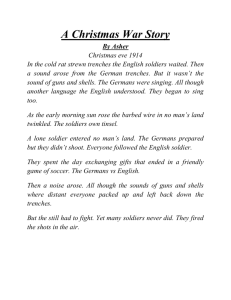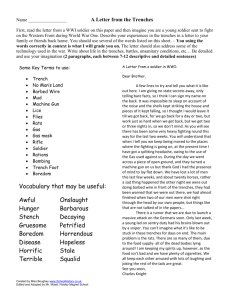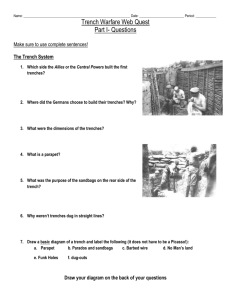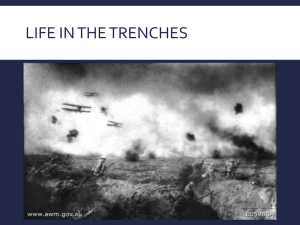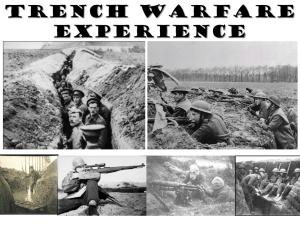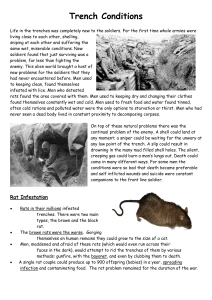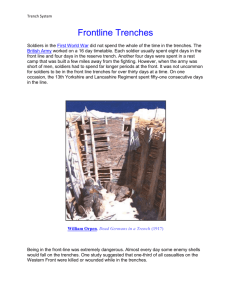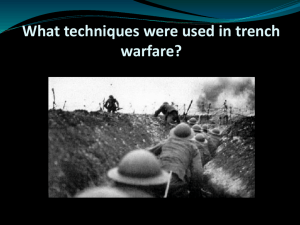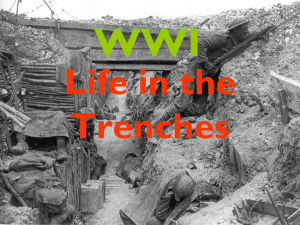Conditions in the Trenches in the First World War
advertisement
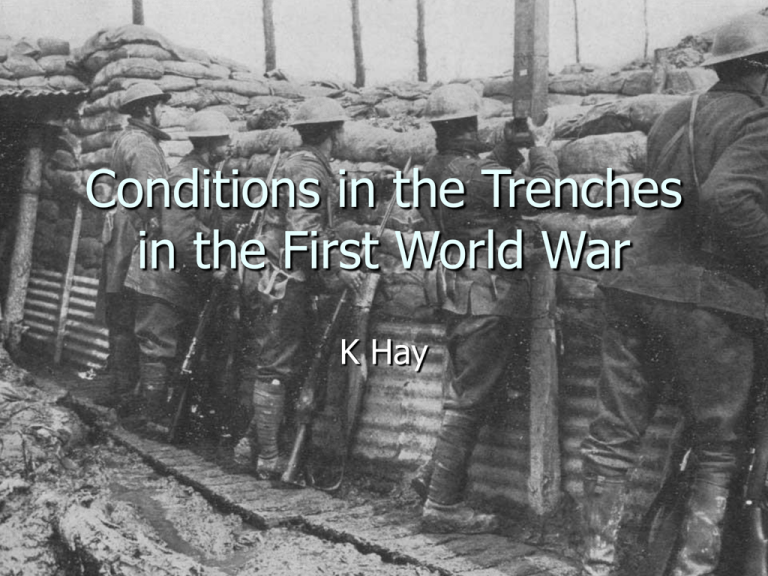
Conditions in the Trenches in the First World War K Hay Conditions in the Trenches Mud Rats and Lice Disease and Illness Food Daily Routine Death and Casualties Weather and Mud Mud was everywhere. Mud penetrated boots, mackintoshes and overcoats. Noone could change their clothes while they were in front line trenches Uniforms became filthy! Mud and the weather were as much an enemy as the Germans. Men had to put up with the most awful living conditions. Most of Northern France where the trenches were situated, was damp, lowlying countryside. The front line troops were seldom dry. Rats Millions of rats infested trenches. There were two main types, the brown and the black rat. Both were despised but the brown rat was especially feared. Rats swarmed everywhere. They fed on leftover food and rotting bodies. By eating all the human remains (and disfiguring them by eating their eyes and liver) they could grow to the size of a cat! Lice Because the men were dirty they became infested with body lice. Lice lived in warm places on a soldier’s body. One soldier counted 103 lice crawling around his body and in the seams of his vest and underpants. They lived by sucking blood. Each louse laid five eggs a day. The best way to kill a louse was by squashing it between thumb and finger. Another way to run a lighted candle up and down the seams of clothes. Disease and Illness Soldiers suffered from a number of diseases and illnesses: Trench Foot Louse infestations Trench Mouth Shell Shock Cholera Mud led to amputation! It was almost impossible for men to keep their feet dry in the muddy trenches. The skin quickly went wrinkly as it does if you are in the bath too long. But then it died and the flesh went black and started to rot. This was ‘trench foot’. In extreme cases the flesh round the toes merged into a stinking pulp. Amputation was the only solution. It was impossible to keep clean at the front and clothes quickly became louse infested. Soldiers were said to be ‘chatty’ and spent hours ‘chatting’ or ‘hunting’ lice and lice eggs in their clothes. The eggs were often found in the seams. The kilt had a big disadvantage here as lice loved living in its folds. The lice caused horrible itchy sores especially around the neck, wrists and ankles. Soldiers who had not brushed their teeth for days on end might suffer from trench mouth. The symptoms were painful – bleeding gums, ulcers of the mouth and throat and very bad breath. Shell shock was caused by fear of the never ending artillery bombardments, shells whistling and screaming in the air. Victims lost control of their limbs. Some foamed at the mouth and became incontinent. The effects of shell shock were often long lasting. Drinking water was often hard to get at the front line and sometimes contaminated water from shell holes was drunk causing cholera epidemics. In the Gallipoli campaign more men died of disease than bullet wounds! Food Soldiers did not go hungry unless enemy action prevented supplies getting through. Each soldier had a food ration. A Typical Diet Bread Hard Biscuits Porridge Cheese Plum and Apple Jam Maconochie Stew Bully Beef Tea Condensed Milk Rum “With us food is pretty scarce and none too good at that – turnips cut into six pieces, unwashed carrot tops – mouldy potatoes. The chief luxury is a thin rice soup with little bits of beef, but they are cut up so small they are hard to find…” Soldier on the Western Front The condition of the food was not a priority! To prepare his food each soldier was issued with a metal mess-tin. Food was brought to the front by ration parties. If they came under attack they and the food could fall into shell holes full of filthy water and rotting bodies! What did the soldiers think about the food? “Wrapping loose rations such as tea, cheese and meat was not considered necessary, all being tipped into a sandbag, a ghastly mix-up resulting. In wet weather their condition was unbelievable…” George Coppard, Soldier on the Western Front “Maconochie, a ‘dinner in a tin’ was my favourite and I could polish one off with gusto, but the usual share out was one tin for four men…I don’t ever recollect receiving an apple or an orange as part of my rations in France.” A soldier on the Western Front Daily Routine Posters always showed men ready and willing to fight. They never showed the boredom of the trenches or actual fighting taking place. What were soldiers doing when they were not fighting? 1. 2. 3. 4. 5. 6. 7. 8. A register was called at dawn Soldiers ate their breakfast Officers’ inspection Platoon sergeant gave out the duties 1/3 of men sent on sentry duty 1/3 of men sent back up the communication trenches for supplies 1/3 worked in the trenches, repairing them Day ends at dusk, when ration parties made their way back with food, stores, parcels and letters A lot of activity happened at night… Night in the trenches was a time of silence and fear. It was also a time of activity. Men stationed in listening posts out in No-Man’s-Land gave early warning of enemy activity, and passed it back to front line trenches, so that the solders would be prepared. Raiding parties went out at night to cut enemy wire before big battles. Snipers went out to kill enemy soldiers who raised their heads above the parapet. They worked in pairs with their faces blackened with coal and wore camouflaged suits. Death and Casualties All the armies fighting on the Western Front were large; casualty figures were enormous. A lot of hospitals, doctors and nurses were needed to cope. What happened to wounded soldiers? At night, after a battle, stretcher parties searched NoMan’s-Land for wounded men. The stretcher parties usually worked in the dark, falling over dead and rotting bodies. Soldiers feared death… All soldiers lived with the sight, sound and smell of the dead and the dying. The fear of death and of the death of friends were amongst the worst things a soldier had to put up with. Total Number of Deaths Britain lost 761,213 people in the war. Most of these were men who died in trench warfare.

